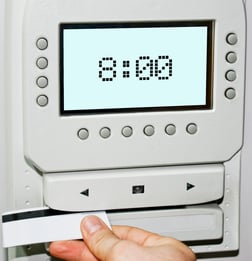
It’s an excellent time for businesses to re-consider which time and attendance technology it is, or isn’t, using as new processes and systems emerge. With the recent rule change from the US Department of Labor (DOL) that more than doubles the white collar overtime exemption pay threshold under the Fair Labor Standards Act (FLSA) companies may want to take a look at how they are keeping track of personnel time and attendance. After all, it’s the employer’s responsibility to ensure that all hours worked by non-exempt employees are recorded and paid. The financial implications of compliance, accuracy, efficiency, and fraud have never been greater.
Some businesses still use a manual process, requiring workers to write times down. That, and physical punch clocks, are obsolete systems. They open up businesses to buddy punching and inaccurate timekeeping and they leave no way of finding out how much it may be costing the company. But even if employees never buddy punch and are always accurate, antiquated time and attendance practices lead to manual process for payroll since the information must be entered into the payroll system by hand. This introduces redundancy, inefficiency, and human error, which is expensive and risky for any business.
Businesses can save that time and money while reducing human error by taking advantage of the technological advances in time and attendance tracking, particularly cloud-based systems that automate information collection and enable easy access and utilization by any departments that need it.
What are New Methods of Time and Attendance Reporting
Magnetic Strip Card
Magnetic strip card systems are widely used because of their simplicity. All an employee needs to do is swipe to clock in and out.
This system is well suited for locations with onsite employees who may not have access to company smartphone, tablet, or computer systems for logging in. It’s also quicker than the older methods, makes it more difficult to buddy punch, and ensures that time is recorded correctly.
Smartphone and Tablet Applications
As tablets and smartphones become more ubiquitous in business, more employers are adding a time and attendance application to allow employees to clock in. For businesses that are attempting to scale up their technology affordably, this system is ideal, as it requires only the software to load onto the tablets or smartphones.
In addition to allowing onsite employees to clock in, remote employees can use their smartphones or tablets as well. This is especially important for a business to consider if a remote employee moved from exempt to non-exempt under the new DOL salary requirement. Using an app for time and attendance, as well as informing the newly non-exempt employees of policies and procedures regarding timekeeping, makes that transition easier.
While time fraud may be a concern for some offsite employees, using a geofencing feature found in many time and attendance applications can alleviate this. The software can use the device’s GPS to allow the employee to clock in, and stay clocked in, only if they are within a predetermined, customizable area.
Biometric Scanners
Biometric scanners are the newest method for time and attendance monitoring. These systems scan an employee’s unique qualities (such as a fingerprint, palm, or iris) to clock in.
This is the best way to prevent time fraud and buddy punching since it uses markers on the employee that can’t be duplicated. This type of system is great for any onsite workers. Oftentimes the fingerprint and hand scanners work even if the employee is in an environment where their hands may become messy, wet, hot, or cold.
Also, this is usually the quickest method to set up, as it involves little to no backend work, such as creating a new code or card. All an employee needs to do is register their marker (fingerprint, palm, or iris) in the system and they are able to clock in and out.
How New Time and Attendance Technology Will Affect Your Business
Adoption of new methods of time and attendance recording will produce results quickly. They are made specifically for more accurate time recording, reducing time fraud, and reducing the workload of several departments.
Businesses should consider the type of technology they want based on where their employees work (on or offsite), the environment the employees are in, and which method best prevents time fraud and buddy punching. Coupled with clear policies and procedures that are relayed to employees, a business can save significant amounts of time and money.





